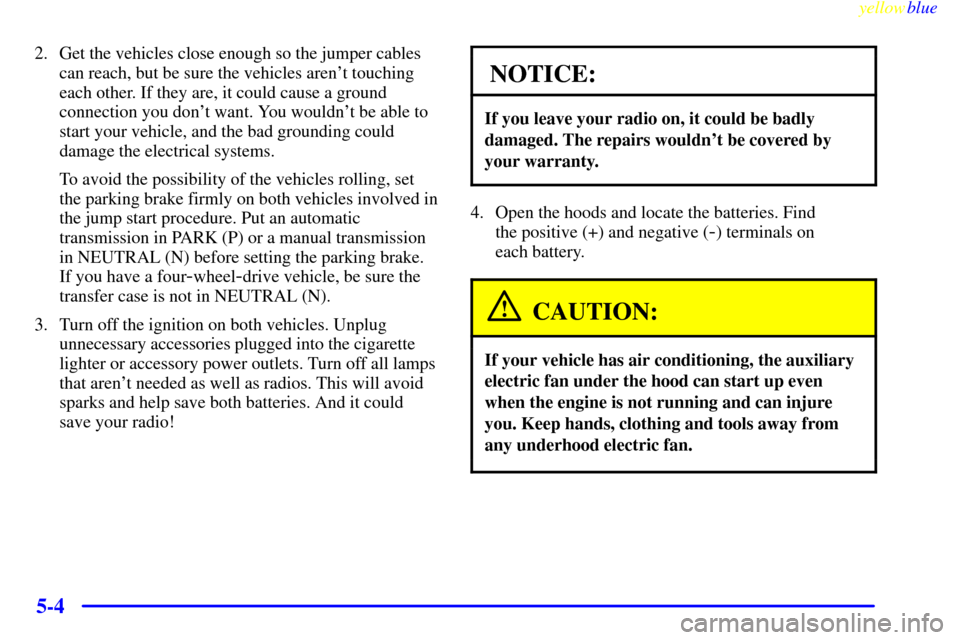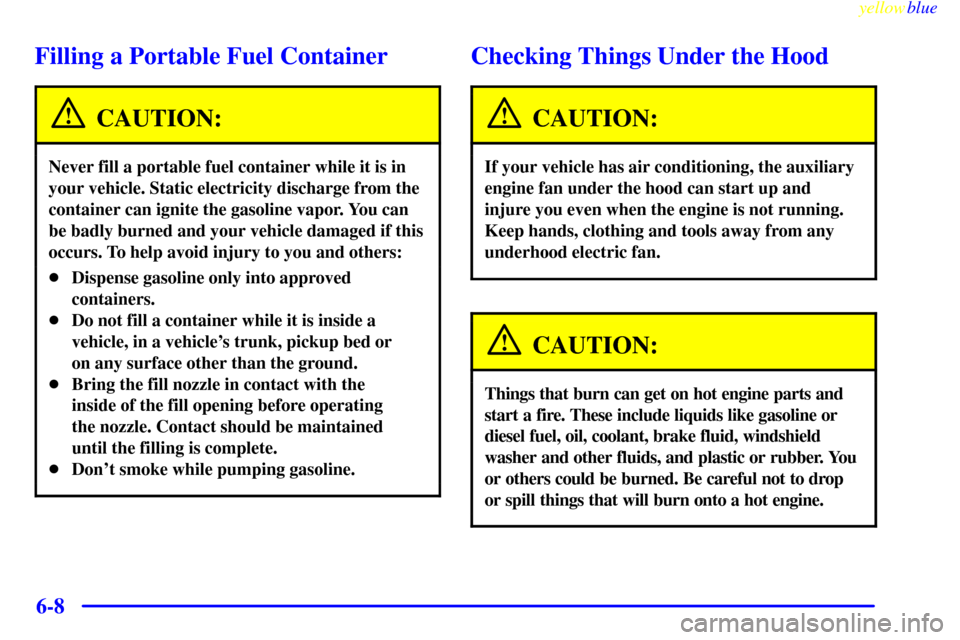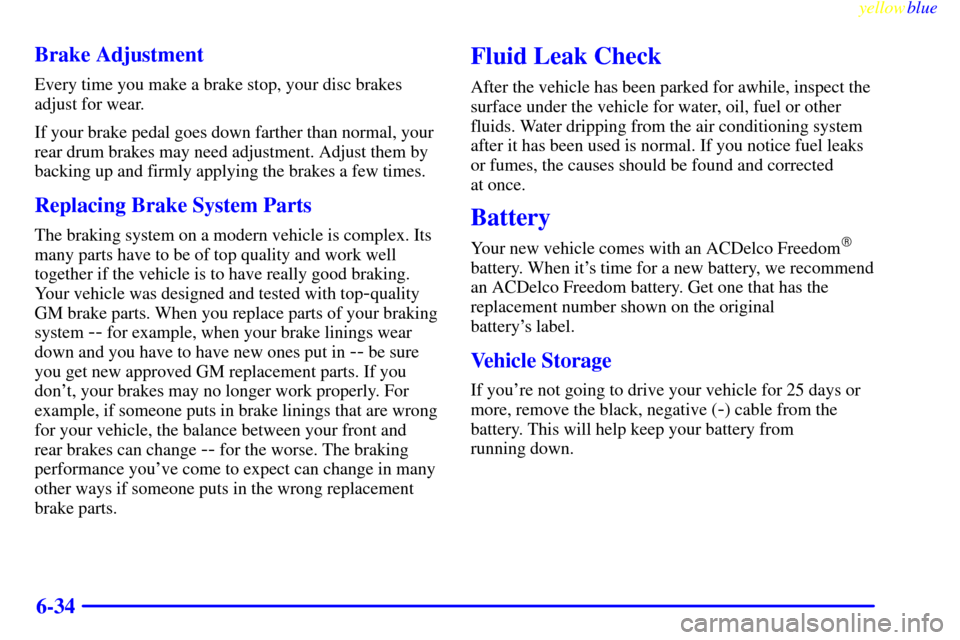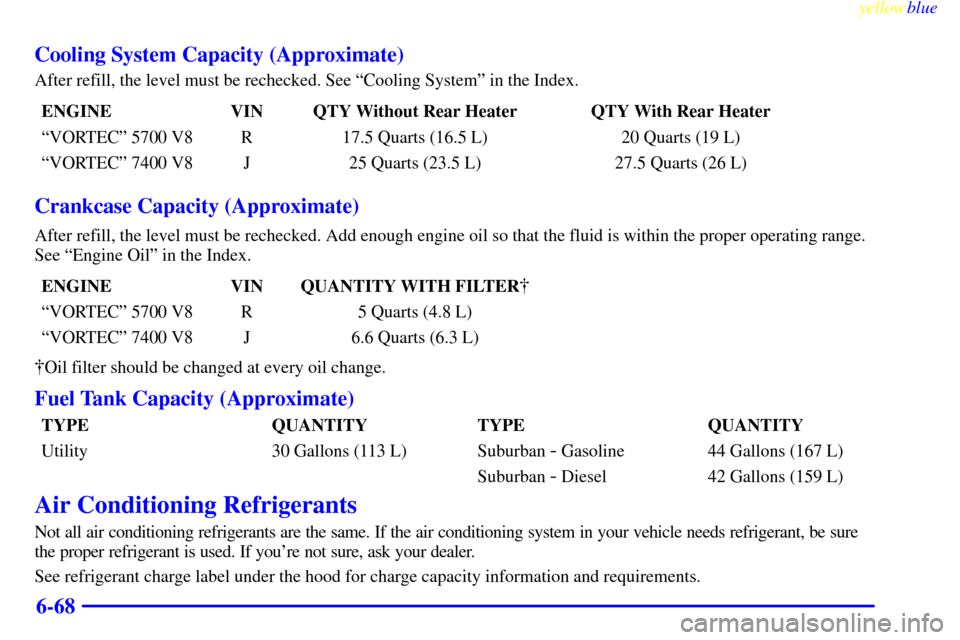Page 246 of 424

yellowblue
5-4
2. Get the vehicles close enough so the jumper cables
can reach, but be sure the vehicles aren't touching
each other. If they are, it could cause a ground
connection you don't want. You wouldn't be able to
start your vehicle, and the bad grounding could
damage the electrical systems.
To avoid the possibility of the vehicles rolling, set
the parking brake firmly on both vehicles involved in
the jump start procedure. Put an automatic
transmission in PARK (P) or a manual transmission
in NEUTRAL (N) before setting the parking brake.
If you have a four
-wheel-drive vehicle, be sure the
transfer case is not in NEUTRAL (N).
3. Turn off the ignition on both vehicles. Unplug
unnecessary accessories plugged into the cigarette
lighter or accessory power outlets. Turn off all lamps
that aren't needed as well as radios. This will avoid
sparks and help save both batteries. And it could
save your radio!
NOTICE:
If you leave your radio on, it could be badly
damaged. The repairs wouldn't be covered by
your warranty.
4. Open the hoods and locate the batteries. Find
the positive (+) and negative (
-) terminals on
each battery.
CAUTION:
If your vehicle has air conditioning, the auxiliary
electric fan under the hood can start up even
when the engine is not running and can injure
you. Keep hands, clothing and tools away from
any underhood electric fan.
Page 253 of 424
yellowblue
5-11
Cooling System (Gasoline Engine)
When you decide it's safe to lift the hood, here's what
you'll see:
A. Coolant Recovery Tank
B. Radiator Pressure Cap
C. Engine Fan(s)
CAUTION:
If your vehicle has air conditioning, the auxiliary
electric engine cooling fan under the hood can
start up even when the engine is not running and
can injure you. Keep hands, clothing and tools
away from any underhood electric fan.
If the coolant inside the coolant recovery tank is boiling,
don't do anything else until it cools down.
Page 281 of 424

6-
yellowblue
6-1
Section 6 Service and Appearance Care
Here you will find information about the care of your vehicle. This section begins with service and fuel information,
and then it shows how to check important fluid and lubricant levels. There is also technical information about your
vehicle, and a part devoted to its appearance care.
6
-2 Service
6
-3 Fuel (Gasoline Engine)
6
-5 Fuels in Foreign Countries (Gasoline Engines)
6
-5 Filling Your Tank (Gasoline Engine)
6
-8 Filling a Portable Fuel Container
6
-8 Checking Things Under the Hood
6
-12 Engine Oil (Gasoline Engine)
6
-16 Engine Air Cleaner/Filter (Gasoline Engines)
6
-19 Automatic Transmission Fluid
6
-22 Rear Axle
6
-22 Four-Wheel Drive
6
-24 Radiator Pressure Cap
6
-25 Thermostat
6
-25 Engine Coolant
6
-28 Power Steering Fluid
6
-29 Windshield Washer Fluid6
-30 Brakes
6
-34 Battery
6
-35 Bulb Replacement
6
-42 Windshield Wiper Blade Replacement
6
-43 Tires
6
-51 Appearance Care
6
-51 Cleaning the Inside of Your Vehicle
6
-54 Care of Safety Belts
6
-55 Cleaning the Outside of Your Vehicle
6
-58 GM Vehicle Care/Appearance Materials
6
-59 Vehicle Identification Number (VIN)
6
-60 Electrical System
6
-65 Replacement Bulbs
6
-67 Capacities and Specifications
6
-68 Air Conditioning Refrigerants
6
-69 Normal Replacement Parts--Gasoline Engines
Page 288 of 424

yellowblue
6-8
Filling a Portable Fuel Container
CAUTION:
Never fill a portable fuel container while it is in
your vehicle. Static electricity discharge from the
container can ignite the gasoline vapor. You can
be badly burned and your vehicle damaged if this
occurs. To help avoid injury to you and others:
�Dispense gasoline only into approved
containers.
�Do not fill a container while it is inside a
vehicle, in a vehicle's trunk, pickup bed or
on any surface other than the ground.
�Bring the fill nozzle in contact with the
inside of the fill opening before operating
the nozzle. Contact should be maintained
until the filling is complete.
�Don't smoke while pumping gasoline.
Checking Things Under the Hood
CAUTION:
If your vehicle has air conditioning, the auxiliary
engine fan under the hood can start up and
injure you even when the engine is not running.
Keep hands, clothing and tools away from any
underhood electric fan.
CAUTION:
Things that burn can get on hot engine parts and
start a fire. These include liquids like gasoline or
diesel fuel, oil, coolant, brake fluid, windshield
washer and other fluids, and plastic or rubber. You
or others could be burned. Be careful not to drop
or spill things that will burn onto a hot engine.
Page 289 of 424
yellowblue
6-9 Hood Release
To open the hood,
first pull the handle inside
the vehicle.
Then go to the front of the vehicle and pull up on the
secondary hood release, located just to the passenger's
side of the center of the grill.
Lift the hood.
If your vehicle has air conditioning, it may have an
auxiliary engine fan in addition to the belt
-driven fan.
Before closing the hood, be sure all filler caps are on
properly. Pull down the hood and close it firmly.
Page 314 of 424

yellowblue
6-34 Brake Adjustment
Every time you make a brake stop, your disc brakes
adjust for wear.
If your brake pedal goes down farther than normal, your
rear drum brakes may need adjustment. Adjust them by
backing up and firmly applying the brakes a few times.
Replacing Brake System Parts
The braking system on a modern vehicle is complex. Its
many parts have to be of top quality and work well
together if the vehicle is to have really good braking.
Your vehicle was designed and tested with top
-quality
GM brake parts. When you replace parts of your braking
system
-- for example, when your brake linings wear
down and you have to have new ones put in
-- be sure
you get new approved GM replacement parts. If you
don't, your brakes may no longer work properly. For
example, if someone puts in brake linings that are wrong
for your vehicle, the balance between your front and
rear brakes can change
-- for the worse. The braking
performance you've come to expect can change in many
other ways if someone puts in the wrong replacement
brake parts.
Fluid Leak Check
After the vehicle has been parked for awhile, inspect the
surface under the vehicle for water, oil, fuel or other
fluids. Water dripping from the air conditioning system
after it has been used is normal. If you notice fuel leaks
or fumes, the causes should be found and corrected
at once.
Battery
Your new vehicle comes with an ACDelco Freedom�
battery. When it's time for a new battery, we recommend
an ACDelco Freedom battery. Get one that has the
replacement number shown on the original
battery's label.
Vehicle Storage
If you're not going to drive your vehicle for 25 days or
more, remove the black, negative (
-) cable from the
battery. This will help keep your battery from
running down.
Page 344 of 424
yellowblue
6-64
Name Circuits Protected
ECM
-B Fuel Pump, PCM/VCM
RR DEFOG Rear Window Defogger
(If Equipped)
IGN
-E Auxiliary Fan Relay Coil, A/C
Compressor Relay, Hot Fuel Module
FUEL SOL Fuel Solenoid (Diesel Engine)
GLOW PLUG Glow plugs (Diesel Engine)
HORN Horn, Underhood LampsName Circuits Protected
AUX FAN Auxiliary Fan
ECM
-1 Injectors, PCM/VCM
HTD ST
-FR Heated Front Seats
A/C Air Conditioning
HTD MIR Heated Outside Mirrors (If Equipped)
ENG
-1 Ignition Switch, EGR, Canister
Purge, EVRV Idle Coast Solenoid,
Heated O
2, Fuel Heater
(Diesel Engine), Water Sensor
(Diesel Engine)
HTD ST
-RR Not Used
LIGHTING Headlamp and Panel Dimmer
Switch, Fog and Courtesy Fuses
BATT Battery, Fuse Block Busbar
IGN
-A Ignition Switch
IGN
-B Ignition Switch
ABS Anti
-Lock Brake Module
BLOWER Hi Blower and Rear Blower Relays
STOP/HAZ Stoplamps
HEATED SEATS Heated Seats (If Equipped)
Page 348 of 424

yellowblue
6-68 Cooling System Capacity (Approximate)
After refill, the level must be rechecked. See ªCooling Systemº in the Index.
ENGINE VIN QTY Without Rear Heater QTY With Rear Heater
ªVORTECº 5700 V8 R 17.5 Quarts (16.5 L) 20 Quarts (19 L)
ªVORTECº 7400 V8 J 25 Quarts (23.5 L) 27.5 Quarts (26 L)
Crankcase Capacity (Approximate)
After refill, the level must be rechecked. Add enough engine oil so that the fluid is within the proper operating range.
See ªEngine Oilº in the Index.
ENGINE VIN
QUANTITY WITH FILTER�
ªVORTECº 5700 V8 R 5 Quarts (4.8 L)
ªVORTECº 7400 V8 J 6.6 Quarts (6.3 L)
�Oil filter should be changed at every oil change.
Fuel Tank Capacity (Approximate)
TYPE QUANTITY
Utility 30 Gallons (113 L)TYPE QUANTITY
Suburban
- Gasoline 44 Gallons (167 L)
Suburban
- Diesel 42 Gallons (159 L)
Air Conditioning Refrigerants
Not all air conditioning refrigerants are the same. If the air conditioning system in your vehicle needs refrigerant, be sure
the proper refrigerant is used. If you're not sure, ask your dealer.
See refrigerant charge label under the hood for charge capacity information and requirements.